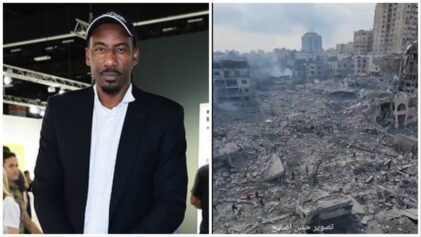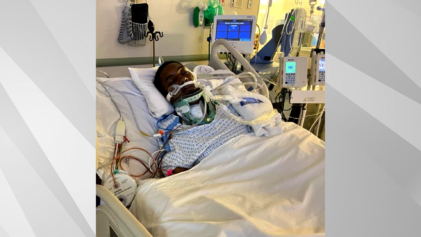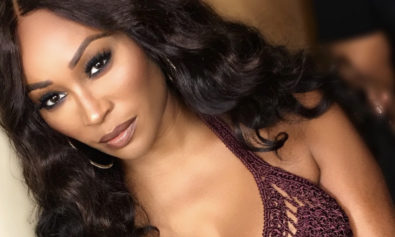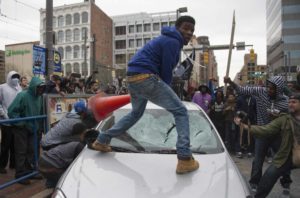
Media portrayals of the crowd of frustrated citizens have slammed Black people as “animals” while quickly denouncing the political strategies being used to push for change in the impoverished city.
But the history of rioting and the nation’s extensive list of protections for animals, even those that have violent tendencies, are yet even more examples of how the media’s framing of protests has failed the people who needed their voice the most.
For more reasons than one, the constant use of “animals” as a new coded word to refer to the Black community has been disappointing and misleading.
Not only does it suggest that Black people are an unintelligent group acting off primal instincts when they are, in fact, enacting a political strategy that has been effective in the past, but it also creates a misconception about the amount of concern America has for Black bodies.
Tensions in Baltimore were not only sparked by the death of Freddie Gray, although his tragic death certainly served as a powerful catalyst for demonstrations, but it was also the result of years of poverty and racially discriminatory systems that forced the people of Baltimore to be trapped in that cycle.
The so-called chaos that swept the streets was the result of a nation of policies that turn a blind eye to how homelessness and unemployment is still an overwhelming problem in predominantly Black communities.
Government officials have shown little to no concern about whether or not Black families in low-income areas have food to eat, a roof over their head, control over their own bodies, the ability to walk down the street without harm, the ability to act in defense and not be labeled a criminal, the ability to be heard or recognition that their environment has a strong impact on their behaviors and future opportunities.

“People—including police officers—are punished for killing or doing harm to domestic animals,” The Guardian’s Jason Nichols explains. “Baltimore has busted dog fighting rings and sent offenders to prison for animal cruelty. In 2014, former Baltimore City police officer Alec Taylor was sentenced to a year behind bars for killing a dog. That might not seem like much, but it is longer than the sentences given to the killers of Michael Brown, Eric Garner, Trayvon Martin, Rekia Boyd or 7-year-old Aiyana Stanley-Jones.”
As painful as it may be to admit or realize, calling Black people “animals” suggests they are more valued by society than has been reflected in recent events.
While people have changed their entire lifestyles—diets, clothing purchases, etc.—in order to ensure the “ethical treatment” of animals, people have barely advocated for the “ethical treatment” of Black people, even in instances where they wouldn’t have been required to personally sacrifice anything.
While people can easily face jailtime for not providing proper shelter for their pet or leaving their animal without a proper caretaker, officials have been overwhelmingly unbothered by the troubling statistics that made Baltimore a virtual powder keg for riots and protests.
“The city’s 8.4% unemployment rate is well above the state average of 5.4%,” Nichols reports before adding that more than 25 percent of the city’s Black population lives in a “food desert, without access to fresh and healthy comestibles.”
Despite a whopping 16,000 reported vacant homes in the city, the homeless population is staggering and nearly 24 percent of the people live below the federal poverty line, making Baltimore the sixth poorest large city in the entire country.
An animal would have never been allowed to live in such a state for so long without someone being held accountable for the deplorable conditions.
“Yes, there has been violence on Baltimore’s streets, but African Americans cannot be compared to animals,” Nichols insists. “Animals don’t have to march to make others concerned with their welfare and wellbeing. Their actions, even when violent, are met with compassion.”
Even as the Black community marches and demonstrates, however, their reasonable demands have still gone ignored.
Black communities have been demanding justice for years, not weeks or months—that’s only the amount of time that cameras have shown up.
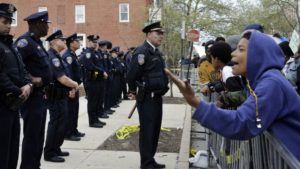
It wasn’t until windows were smashed, buildings were burned and bricks were tossed that the cameras appeared at every corner and national attention was drawn to the unbelievably bleak circumstances that these people knew as everyday life.
While it is true that the vast majority of protesters in Baltimore were peaceful, those who responded with vandalism should not be discounted as mindless thugs.
“As a nation, we fail to comprehend Black political strategy in much the same way we fail to recognize the value of Black life,” Salon’s Benji Hart writes. “…Referring to Black Lives Matter protests, as well as organic responses to police and state violence as ‘non-violent’ or ‘peaceful’ erases the actual climate in which these movements are acting, the militant strategies that have rendered them effective, and the long history of riots and direction on which they are built.”
That’s the same premise that caused Grey’s Anatomy star Jesse Williams to take to Twitter to condemn those who are criticizing citizens in Baltimore who have resorted to more radical methods of obtaining justice for what seems to be a forgotten community.
“If we view rioting as a mass temper tantrum expressed through violence & property damage, white sports fans do that monthly #Tradition,” Williams tweeted. “1 group can burn & loot when a team scores less points than another but when paid public servants kill citizens, we gotta be BaggerVance? Where are all the think pieces & coverage of the pathology of white culture every time white frustration vents violence & destruction? There is nothing “Black” about rioting. How do you think we got all this land?”
That’s when Williams, who is no stranger to using his celebrity as a public platform to push for racial equality and justice, gave an important history lesson about riots.
“Historically riots have been tools for intimidation; destroying populations, taking land & valuables. #BlowingOffSteam #BoysWillBeBoys,” he tweeted. “Whites rioted through the early 1900s, slaughtering, burning & looting entire thriving black townships, just because of the adjective.”
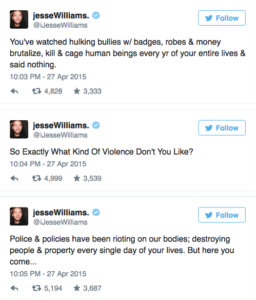
“You’ve watched hulking bullies w/badges, robes & money brutalize, kill & cage human beings every yr of your entire lives & said nothing. So exactly what kind of violence don’t you like,” he continued. “Police & policies have been rioting on our bodies; destroying people & property every single day of your lives. But here you come…When the beaten, marinated in centuries of trauma, pain & distress, manage to muster a response, here you come, squealing; revealing.”
That militant response that is so quickly condemned in the public eye when Black people are involved is one that has been effective and has a vastly different purpose than white race riots of the past.
While those historical riots aimed specifically to hurt the lives of innocent people, the so-called “non-peaceful” tactics in Baltimore are “disrupting white consumerism and destroying state property” in an attempt to stop “the machine that is trying to kill [the Black community],” Hart explains.
As long as those acts are not turned against the very community being oppressed or harming those who are also seeking justice, these “rioters” are not mindless vandals at all—they are political activists engaged in a strategy that has actually been more successful than its “non-violent” alternatives in the past.
That is what truly makes the difference between those turning their rage on cop cars and those who are blindly attacking local grocery stores and Black businesses.
In the midst of the chaos, groups are coming together in an attempt to make sure those means of calling for change do not turn to mindless criminal acts or counter-productive destruction.
The 300 Men March movement has been calling on local men to form a barrier between the young activists and police as they continue to demonstrate and push for justice.
“We’re like the neutral force,” Munir Bahar, the co-founder of the 300 Men March movement explained to the Huffington Post.
The group was originally formed to help combat gun violence and murder rates in Baltimore but they were easily able to see where their place was with the marches in support of Freddie Gray.
As police presence caused tensions to boil and force to be used by both parties, the 300 Men March members ensured that protesters were protected from police and police were protected from protesters.
“We’re here to bring comfort to the community,” he said. “It’s really just to inspire hope and more importantly to show these young guys that there are some older guys who care.”
The group has worked closely with police and the protesters to try to make sure activists have the right to have their voices heard without being harmed by authorities.
Meanwhile, reports that local gang members reached a truce solely in the name of killing cops are being denounced by gang members.
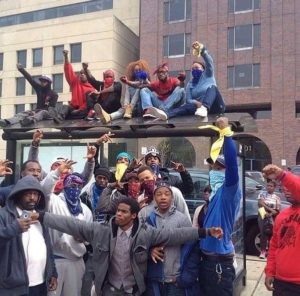
“We want the people of Baltimore City to know that the image they are trying to portray of gangs in Baltimore—the [Black Guerilla Family], the Bloods, the Crips—we did not make that truce to harm cops,” a man who identified as a member of the Bloods gang told Baltimore’s NBC affiliate WBAL 11.
While it is clear that gang members have come together to march and rally for justice, they say that’s the extent of the partnership. They are not teaming up to take the lives of police officers.
“We did not come here to harm cops,” he added. “We’re not about to allow y’all to paint this picture of us.”
Another gang member added that all of the men involved just “want justice for Freddie Gray. “
The gang members then sent out an urgent plea to the public to be wary of what they see in the media as the entire story is being misconstrued and disfigured to serve ulterior motives.
While images of protesters smashing cars or burning buildings have made national headlines, he pointed out that there has been little mention of the people downtown who hurled barstools, beers and racial slurs at demonstrators as they made their way through downtown.
